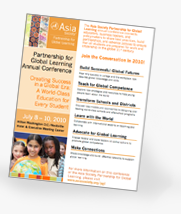Create Success in a Global Era
The world in which today’s students will graduate is far different than the world in which we know now. As never before, American education must prepare students for a world where the opportunities for success require the ability to compete and cooperate on a global scale.
The globalization of economies, the rise of China and India, advances in science and communications technology, acceleration of international migration—and the fact that virtually every major health, environmental, and human security challenge Americans face can be solved only through international collaboration—will require our high school graduates to be far more knowledgeable about world regions, cultures, and global issues.[1] But we have not emphasized such skills in our schools. A 2007 report from the National Academy of Sciences warns, “The pervasive lack of knowledge of foreign cultures and languages threatens the security of the United States and as well its ability to compete in the global marketplace and produce an informed citizenry.”
Innovations in Schools and Communities
Over the past few years, schools and communities across the country have begun to respond to this new reality and are seeking to redesign education to produce students who are both college ready and globally competent.
Consider this example: The Walter Payton College Preparatory High School in Chicago, an inner-city magnet school that is one of Chicago’s most ethnically diverse schools, has shown how integrating global content enhances academic excellence. Founded in 2000 and now one of the top schools in Illinois, the school’s mission is to prepare students for “leadershipin their community, the nation, and the world.” Every student studies a world language for four years and experiences a home-stay exchange with a sister school in China, France, north Africa, Japan, Switzerland, Chile, Italy, or South Africa. Use of technology, including videoconferencing, connects Payton classrooms to their sister schools and to subject-matter experts around the world. An array of international visitors, students, and seminars further develops the international spirit of the school. The school is also the flagship of Chicago’s Chinese language program, the largest Chinese program in the country. This award-winning school is clearly an outstanding school. But data collected on hundreds of schools from more than 40 states and from rural and inner-city areas, as well as suburban and private schools, show that many schools are embarking on similar journeys. Our research shows that schools typically start in a small way and gradually broaden their approaches. Over time, globally oriented schools develop key common elements. These schools:Consider this example: The Walter Payton College Preparatory High School in Chicago, an inner-city magnet school that is one of Chicago’s most ethnically diverse schools, has shown how integrating global content enhances academic excellence. Founded in 2000 and now one of the top schools in Illinois, the school’s mission is to prepare students for “leadershipin their community, the nation, and the world.” Every student studies a world language for four years and experiences a home-stay exchange with a sister school in China, France, north Africa, Japan, Switzerland, Chile, Italy, or South Africa. Use of technology, including videoconferencing, connects Payton classrooms to their sister schools and to subject-matter experts around the world. An array of international visitors, students, and seminars further develops the international spirit of the school. The school is also the flagship of Chicago’s Chinese language program, the largest Chinese program in the country. This award-winning school is clearly an outstanding school. But data collected on hundreds of schools from more than 40 states and from rural and inner-city areas, as well as suburban and private schools, show that many schools are embarking on similar journeys. Our research shows that schools typically start in a small way and gradually broaden their approaches. Over time, globally oriented schools develop key common elements. These schools:
- Create a global vision and culture by revising their mission statements and graduate profiles and creating a school culture that supports internationally focused teaching and learning;
- Develop an internationally oriented faculty by recruiting teachers with international interests and encouraging teachers to take advantage of the many professional development and study/travel opportunities offered through universities and international organizations;
- Integrate international content into all curriculum areas, bringing a global dimension to science and language arts, as well as social studies and languages;
- Emphasize the learning of world languages, including less commonly taught languages, such as Chinese and Arabic;
- Expand student experiences through internationally oriented service learning, internships, and partnerships and exchanges with schools in other countries; and
- Harness technology to tap global information sources, create international collaborations, and offer international courses and languages online, especially to underserved communities.


